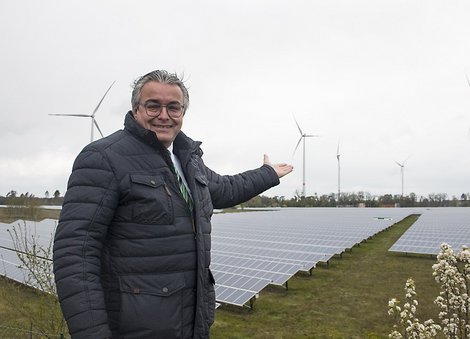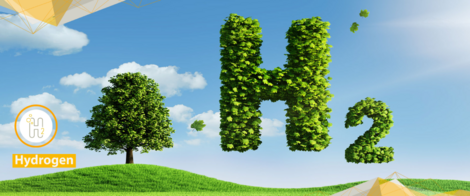Hydrogen as a key technology: A network for the energy transition
The energy park in the town of Zerbst in Saxony-Anhalt is planning to generate green electricity using renewable sources and electrolysis.

A flagship project for the energy transition is underway in Zerbst in Saxony-Anhalt, where the energy service provider GETEC is working with partners from industry and research to establish a green energy park that will generate electricity from solar and wind energy and from biomass. Now an electrolysis plant and the accompanying logistics infrastructure for producing and distributing 100 percent green hydrogen for regional use are being built.
Today there is very little solar energy in evidence, but the wind turbines are spinning in a strong breeze. Chris Döhring pulls up the collar of his jacket and makes a sweeping movement of his arm to indicate the area that was his vision in the early 2000s and is now a flagship project of the energy transition: the Zerbst Energy Park. Aircraft hangars overgrown with vegetation remain from the period after 1936 when the site was a German Luftwaffe airbase. After 1945, it was used by the Red Army and then following reunification it was taken over by the German government. The GETEC Group, which was founded in 1993, purchased a large part of the airbase close to the town of Zerbst in 2003. The energy service company from Magdeburg, which now has customers throughout Europe, specializes among other things in developing green usage concepts for contaminated sites like this one.
Chris Döhring (52) is an energy and environmental engineer. He joined GETEC in 2004 when wind turbines had already been erected on the outskirts of Zerbst. At the time, there was significant local opposition to the turbines and protests were held with slogans ranging from “Spoiling the landscape” to “Ruining the future.”
GETEC is one of the pioneering firms which stayed true to its visions. Now that all the signs are pointing toward the energy transition, it is playing a leading role in the field of renewable energy. “We are running renewable energy supply projects for municipalities, businesses, farms and investors which are designed for the local conditions,” says Chris Döhring, who is now CEO of GETEC green energy GmbH.
Comprehensive forward-looking project includes environmental protection
The Mitteldeutsche Energieverbund Zukunft (the central German future energy network) is a comprehensive project initiated by GETEC green energy that will use the most recent key technologies to generate sustainable energy from solar and wind power, biomass, ground heat, hydropower and hydrogen. The energy parks in Zerbst, Börde, Profen and Amsdorf have come together in the project.
The Zerbst Energy Park has large amounts of solar and wind power and biomass at its disposal. There are photovoltaic systems as far as the eye can see: 194,256 solar panels over an area of 108 hectares. Behind this are 14 wind turbines up to 200 meters high and in the middle is a biogas plant which supplies biomethane. This is produced from chicken manure, maize and green waste delivered by farmers from the region.
In the Zerbst Energy Park, “green” as a color symbolizing protection for the environment is a very accurate description. A herd of Galloway cattle grazes in the fields in front of the plant. Meadows have been planted with fruit trees and beekeepers put their hives under the acacias. Part of the site is a park in the other sense of the word: a public space where people can meet and enjoy leisure activities and sport. In addition, religious services are held in a historic aircraft hangar.
Mobile storage eliminates fluctuations
In the heart of the energy park, a plant for generating 100 percent green hydrogen for regional use will soon be built. GETEC green energy is one of the partners in this project with responsibility for planning. Chris Döhring is happy to show interested visitors around the site, which is still overgrown with vegetation, to make sure that they will be impressed in the future by the “after” picture. The electrolysis plant is expected to go into production at the end of 2022. It will be operated by Bio-Masse-Hof Zerbst GmbH and the other partners in the project are the town of Zerbst, the BioPharmaPark Dessau-Roßlau, Erdgas Mittelsachsen GmbH (EMS) and DHW Deutsche Hydrierwerke GmbH in Rodleben. According to Chris Döhring, the hydrogenation factory (DHW) will be the first customer for the green hydrogen from Saxony-Anhalt. The factory runs energy-intensive processes to produce fatty alcohols, fatty amines and sorbitols, among other things, and is currently using grey hydrogen manufactured from fossil fuels.
In future, the electrolysis plant at the Zerbst Energy Park will be completely powered by wind energy. For this purpose, seven new wind turbines will be built on neighboring sites that because of their contamination levels have previously only been used as leach fields for processing wastewater.
In addition to the electrolysis plant, a gas logistics system has to be built. This includes compressors that compress the hydrogen until it reaches the required pressure and a mobile hydrogen storage unit that is used to compensate for fluctuations in the renewable electricity generated from wind power. This small-scale distribution system is being developed by the Fraunhofer Institute for Factory Operation and Automation IFF in Magdeburg. The IFF is the research partner for the expansion of the Zerbst Energy Park.
Model region attracts many companies
According to Chris Döhring, the Zerbst Energy Park will play a pioneering role on a national level with regard to the variety of types of renewable energy available there. The park will have a filling unit for mobile hydrogen tanks to supply customers in the region and a public filling station for hydrogen fuel cell vehicles.
In addition, it will be connected to the existing central German hydrogen network 20 kilometers away, which links together the major chemical and industry parks in Bitterfeld-Wolfen, Leuna, Schkopau, Böhlen-Lippendorf and Zeitz.
Döhring predicts that the wide range of renewable energies will attract start-ups and encourage existing companies to relocate. The synergies are already noticeable. “There are a lot of companies looking for new business opportunities because of the phase-out of coal that are drawn to a CO2-free model region for hydrogen.”
Now the wind blows the clouds away to reveal the sun. “It’s taken a while...,” says Chris Döhring, referring also to the realization of his visions following the changes in the social and political environment. Döhring is now directing his entrepreneurial energies into the brown coal mining region around Profen. In areas where the mines are being shut down, he aims to start the production of green hydrogen very soon.
Author: Kathrain Graubaum/IMG Saxony-Anhalt

Saxony-Anhalt offers good starting conditions for the development of a forward-looking hydrogen economy.
As a traditional chemical site, the state has many years of experience with hydrogen utilization in the Central German Chemical Triangle.
